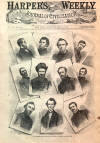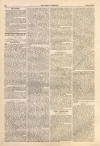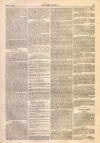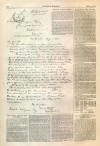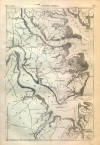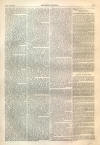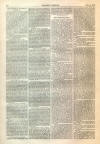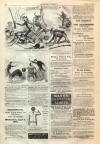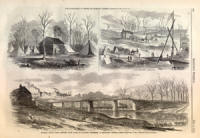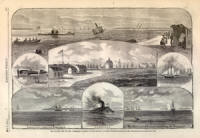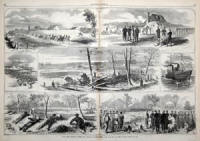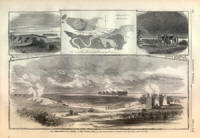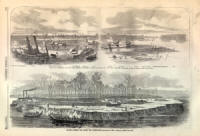British Naval Fleet Obsolete
|
|
This Site:
|
HARPER'S WEEKLY. [MAY 3, 1862. 274 OUR SUCCESS.THE regular circulation of Harper's Weekly is now between ONE HUNDRED AND TWENTY-FIVE and ONE HUNDRED AND THIRTY THOUSAND copies. Assuming that each number of the paper is read by ten persons—a moderate estimate—a million and a quarter people derive instruction and amusement from this journal. It affords us no little satisfaction to witness this success. Certainly we may say that no effort on our part has been wanting to deserve it. Our weekly expenses for traveling artists are alone as heavy as our total outlay for artistic labor used to be when Harper's Weekly was first established. This outlay, however, enables us to depict, week by week, the progress of our arms along the whole circumference of the Rebellion, with a fidelity and vividness seldom equaled. We are besides enabled to lay before our readers each week several pages of the best reading of the day, including the works of Dickens, Wilkie Collins, and Bulwer. So remarkable a combination of artistic and literary excellences has never been presented in any journal, either in this country or abroad. We think that this Number, for instance, will bear comparison with any number of any paper ever produced in the United States or in Europe. HARPER'S WEEKLY.SATURDAY, MAY 3, 1862."HARPER'S WEEKLY" AT FORTRESS MONROE.WE learn by telegraph that the sales of the last Number of Harper's Weekly were stopped at Fortress Monroe in consequence of pictures of Yorktown and the vicinity. The pictures inculpated represented Big Bethel as it appeared when it was occupied by our troops, and the rebel lines at Yorktown, with the position of our forces when they first appeared before the place on 7th April. Both were from sketches by an Officer of Topographical Engineers, and were sanctioned by the commanding officer of the corps. Both, as any competent military man could see, were so drawn as not to reveal any position permanently occupied by our forces, or to convey any information whatever to the enemy. Ever since the contest between the United States forces and the rebels became grave this journal has been so conducted as to impart no information to the enemy. We have frequently withheld from our subscribers interesting pictures, fo`r fear they might prove useful to the traitors. We have pursued this course not only with regard to our army at Yorktown but every where. We shall continue to do so. Rather than publish a line or a sketch which could by any possibility injure the Union cause, or endanger the success of our gallant soldiers, we would suppress this journal altogether. With the consciousness of this purpose we beg leave to state that we shall not allow our business to be interfered with at the whim of any military officer whomsoever, and that any General who undertakes to stop the sales of Harper's Weekly, or to interfere with its circulation, does so at his peril. We shall hold him responsible for damages before a jury of his country. We recommend Brigadier-General Wool, and Censor A.D.C. De Witt Clinton, to devote more attention to the duty of suppressing the Southern rebellion, and less to the suppression of Northern newspapers. By doing so, the former will not again publish such predictions as the one in which he informed Secretary Stanton that M'Clellan would meet with no serious resistance at Yorktown; and the latter will have more time to perform the proper and reputable functions of an A.D.C. GRADUATING AS SOLDIERS.A CHANGE has come o'er the British dream. The bullies who, three months ago, when we were in deepest trouble, were boasting that they would send the Warrior to bombard "the cities of New York and Hoboken," and dictate peace with Armstrong cannon pointed at peaceful dwellings full of women and children, are now humbled and panic-stricken. The battle of the ninth March has filled them with terror. They realize that that battle destroyed, not only the Cumberland and the Congress, but likewise the entire British navy; that the "wooden walls of England" are gone; that the British Navy "consists of two ships, the Warrior and the Black Prince," both probably failures; and that, in all probability, before New Year 1863 the United States and France will both be as superior to Great Britain at sea as they now are on land. Under the pressure of these distressing reflections John Bull has set to work to build Monitors on the plan of Captain Ericsson, taking care, after his usual fashion, to claim our gallant countryman's invention for an Englishman of the name of Coles. We think we may safely say that the panic which appears to be prevailing in London in consequence of the performance of the Monitor is only the first of a series of fits which this war of ours is destined to occasion in Europe. In the first place, the Monitor is only an experiment, and by the time Great Britain has spent a few millions in building copies of her, a very improved model will probably have been adopted here. The six Ericsson batteries which are now being constructed for Government are greatly superior in many respects to the antagonist of the Merrimac. Another fight will suggest further improvements. In the course of the next sixty days the Galena, the Roanoke, and the Kensington will have been under fire, and will have taught us further lessons. It may be that the Monitor, though capable of coping with a rude product of Southern skill like the Merrimac, will be found inferior to one or all of these vessels. Captain Ericsson himself does not regard his model as a "finality," though it is obviously a step in advance of previous models. There are many competent sailors and naval authorities who deem the Vanderbilt the most formidable war vessel afloat in our waters. Commodore Porter, now in command of the mortar fleet at New Orleans, is understood to have declared, ten years ago, that he would undertake to fight any ship-of-the-line with the old George Law, which was lost in 1858, and which carried no guns at all. It may turn out that, for all purposes of naval combats between ship and ship, guns are a superfluity, and that the only things needful are speed, a sharp beak, and an invulnerable hull. Thus, while there is every reason to believe that the little Monitor, now lying in Hampton Roads, would destroy the whole British navy—including the Warrior and the Black Prince—in a very short time, without receiving any material injury herself, it is far from likely that the Monitor will be the most formidable vessel in our navy a few months hence. Meanwhile the progress made in offensive weapons is as great as in defensive armor. This war of ours has revolutionized the science of artillery. At Sebastopol the guns used were smooth bores. There was a Lancaster gun at one time in battery, but it did not answer and was discarded. In the Italian war rifled 4 and 6 pounders were used by the French with satisfactory results. In the Chinese war Armstrong 12-pounders were used for short periods of time, and their performance was well spoken of: no opportunity offered for discovering their well-known defects. We are now arming our ships with rifled 100-pounders; the new Monitors are to carry 15-inch guns, throwing balls weighing 500 pounds. Our siege batteries consist of rifled 30 and 40 pounders, and 68 and 100 pound Columbiads. The results of the change is seen in the reports of the bombardment of Fort Pulaski. Heretofore 400 yards has been considered fair breaching distance, though artillerists are recommended in the text-books to get 100 yards nearer if possible. Two years ago a gunner who had proposed to erect a breaching battery at half a mile from the wall to be attacked would have been set down as insane. Our breaching batteries at Pulaski were nearly a mile from the work, yet they made a practicable breach, in a wall previously deemed impregnable, in the course of thirty hours. This was done by a judicious combination of rifled guns, carrying 30 and 40 pound shot, and very heavy Columbiads. The former, as is well described in Commander Rodgers's report, bored their way into the wall, while the latter, coming into play afterward, so pounded the honey-combed stone and brick work that it gave way and crumbled into ruin. This bombardment demolished not only Fort Pulaski, but all the stone forts in the world. Not a fort in Europe could stand 48 hours' bombardment by a combination of heavy rifled guns and Columbiads. They were well enough when opposed to smooth 18, 24, and 32 pounders. They would crumble directly under a fire of 68 and 100 pounders from James or Parrott guns. We have thus, in the course of a year's war, established the utter inability of any of the existing navies or forts in the world to resist an attack from the vessels and weapons which we are now using. And we are only just beginning to learn. In the course of the next six months our weapons of offense and defense will probably be as far superior to those now in use as the latter are superior to those which were used a year ago. We hear already that General Gilmore is prepared to breach Fort Sumter at Charleston at a distance of 2000 yards. We understand that the Monitor has lately been provided with a missile which will penetrate the iron sides of the Merrimac as easily as if they were made of wood. Captain Rodman, under whose direction six 15-inch guns are being cast at Pittsburg for the new Monitors, has cast a 20-inch gun, and is experimenting with 30-inch guns; he expects to cast guns for coast defense which will throw a ball weighing three thousand pounds. Should the Warrior, in the course of her attempt to bombard "New York and Hoboken," come in contact with one of these little missiles, it would be a matter of difficulty, ten minutes afterward, to find out what had become of her, or where she was when her voyage was abruptly terminated. In the opinion of a Prussian officer who recently left this country, there is no army in the world so completely equipped, in regard to artillery and rifles, as the army of the Potomac. There are picked regiments in France and in Germany as well armed as any of ours. And there are batteries of artillery in many countries equal to any thing on this side the ocean. But nowhere in the world, except on the Potomac, does there exist a body of 200,000 men all armed with the best possible weapons, or a park of 400 pieces of light artillery, all perfect and of the best make and most effective character. This Prussian officer declared that the Emperor Napoleon had no such army under his command. He might have added that no army but ours possesses such a corp as the Berdan sharp-shooters, with their telescopic rifles. The sharp-shooting in the Crimea and in Italy was mere boy's play in comparison with the performance of the men of this regiment, who pick off gunners at a distance when their forms can barely be descried by the naked eye. In the words of Colonel Lysons—probably the most experienced officer of the British army—"as soon as the regimental officers in the army of the Potomac become more efficient—a matter of time—that army will be simply irresistible." The Americans have not been a fighting people for many years. The Mexican war was a diversion, and did not excite the people at large. Not since 1812 has the whole popular mind been directed to military pursuits. No people in the world had less knowledge of real warfare, or less general acquaintance with the practical business of fighting, than we had when this wretched rebellion forced the sword into our hands. In the course of a single year, however, we have revolutionized gunnery, naval architecture, and fortification, and have raised an army which is admitted by competent foreign judges to be without an equal in the world. It is to be hoped that, after the suppression of the rebellion, our foreign friends will permit us to convert our sword once more into a pruning-hook. But if not, the experience of our present troubles will probably enable us to effect some important changes in the map of the world. YULEE'S LETTER.THE letter of Mr. Yulee, late Senator from Florida, of which we give a facsimile on page 278, is by far the most important published document in the secret history of the war. It establishes the fact of the elaborate conspiracy which resulted in the armed rebellion. It is an utterly infamous letter; for the writer was, at the moment of writing, a sworn and paid officer of the Government against which he was conspiring, while Mallory, now rebel Secretary of the Navy, was chairman of the Naval Committee of the Senate. Mason and Hunter, then Senators from Virginia, were also conspirators. Mason told a friend, in the middle of February, that he hoped the Union could be saved, and the next day he wrote to a friend in Paris the details of the plan to destroy it. Hunter and Slidell waited upon a Northern gentleman in Washington at about the same time, and told him that every thing was ready—that there might be a little fighting, but no serious work—that Pennsylvania and the West would adopt the Montgomery Constitution, and New York would not long delay, while New England might be left out of the reorganized government, or admitted as a single State. This course was also urged openly or covertly by certain newspapers in some Northern cities. The Vice-President, Breckinridge, another conspirator, sneeringly asked Andrew Johnson, in Washington, whether he thought the Government could coerce States? Even the most patriotic citizens could not help at least wondering whether there would be an overwhelming rally of the whole North for the Union. They did not wonder after the fall of Sumter. The plan of the conspiracy clearly contemplated that some of the Confederates should nominally remain uncommitted, in order to perplex the Government. Breckinridge was one of these. And when the developments of Time allow the history of the rebellion to be fully known and written, it will appear that the Catiline conspirators in Rome, and the Jacobite malcontents in Great Britain, had never a more thorough organization than that of which Jefferson Davis is the acknowledged head, and Yulee proves himself an accomplice. THE LOUNGER.THE NATIONAL ACADEMY.THE Derby Gallery is light and spacious, and an admirable room for the Exhibition. There are two smaller rooms opening out of it, one of which is lighted by gas, which does not help the pictures. The general effect upon entering the large room is bright and agreeable, and it is enhanced by the pleasant anticipation which always invests pictures which are yet to be seen. The impression upon leaving is one of disappointment. That impression must be understood, of course, of the general effect. There are very fine pictures in the Exhibition—some of the best portraits, for instance, that we have ever had—but it has evidently not been a very happy year for painters. The war itself has not inspired many works. Mr. Gifford's Sunday Morning in the Camp of the Seventh Regiment near Washington (104) is the chief of these, and it is remarkable for the fidelity with which the personality of the chaplain. the Rev. Mr. Weston, is rendered. This Lounger has seen that gentleman but once, and in the picture his back is to the spectator, but the individuality of the man is unmistakable. Mr. Gifford is one of the artists who, during the year, have preserved the traditions of Michael Angelo, by patriotic service under canvas as well as on it, The first of the large portraits is Mr. filches full-length of Dr. Cogswell, late chief of the Astor Library (14). He is sitting in the Library, holding a book. The picture should be studied from across the room, and it will then be seen that it one of the most admirable works of the painter. The likeness is capital. The accessories are remarkable. They are painted with great fidelity and propriety of detail: the books are books, the carpet is carpet, the wood is wood. The clothes of the worthy subject, however, seem rather too shining for broadcloth—and yet the true bibliophile has always been noted, like the angels, for shining garments. So characteristic and satisfactory a portrait as this of the famous Librarian of the Astor ought certainly to belong to the Library. Side by side with a good likeness of the founder, it would go down to the respect and interest of posterity, for whom Astor devised and Cogswell collected and arranged. It is properly a historic portrait, and its fit place is the Astor Library. No. 44 is Page's portrait of Collector Barney, a picture full of power and skill, but, from some reason, not pleasing. The likeness is excellent, but the accessories are disagreeable. Where he is, or what he is doing, it would be difficult to say. But Mr. Page's works are too important, too carefully considered, and too thoughtfully wrought, to be hastily dismissed and we shall return to his portraits, of which there are two others upon the walls, full lengths, of a gentleman, and a lady and a child. Mr. Huntington's Chancellor Ferris (58) is a broad, free, strong, and effective portrait. The Chancellor stands in his flowing robes; with his hand upon an antique tome and a stained window before him. The frank, benign dignity of expression is simply true to life. In the painting the artist has not been in the least afraid of purple. The coloring is rich and harmonious, and the work is a fine specimen of the artist, full of talent, and a most valuable portrait to the University. In No. 111 Mr. Elliott exhibits the best portrait that we recall from his hands. He has a uniform excellence. Unlike many artists, authors, and orators, who are sometimes very good and sometimes bad, Elliott is always good. The spectator is always sure of vigor, brilliancy, and fidelity. But in this portrait there is a subtlety that he does not always show. The incisive force of character in the subject, the maturity of sagacity, alertness and prudence which mark the master of his calling, have been seized with enthusiasms by the painter, and reproduced with corresponding skill. He had the good fortune in the portrait of treating a face in which the individuality is thoroughly indicated, and he has done it ample justice. It was fortunate too that the very coloring of the subject was most congenial to the pallet of the painter, so that he has given us one of the most real, living portraits that have hung in any Academy exhibition. In the farther room, under the gas, are sixteen works of Paul Duggan, who died a few months since in Paris. They are chiefly portrait drawings, and there are two models in plaster, curious and elaborate studies in anatomy. The portraits are of well-known persons, and most of them will have a three-fold interest to many visitors of the Exhibition: first, as Duggan's works; second, as heads of noted people; third, from their association with the Century Club, upon whose walls they habitually hang. Indeed, in that dim corner of the Exhibition where they are, we can hardly see the drawings for Darley's portrait of the artist which hangs among them. How often before the pictures of the Exhibition that slight, wan, partly stooping figure stood silent and rapt, intently gazing and calmly discriminating, yet ever with kindness and sweet humor! How inly smiling and cordial he stole through the crowds on the gay evening and in the old rooms, as with the same cheerful silence and genial sympathy he passed through the press of life to his grave! His patient life, his quiet heroism, his cheerful submission, were they not all signs of the permanent satisfactions of that keen sense of beauty and sympathy with it which are the mainsprings of art? The Academy have obeyed a pious instinct in placing among the paintings of our living artists these works of their brother so lately dead. Next week we shall have another look at the Exhibition. FORWARD!THE President's signature to the District Emancipation Bill is the first practical proof of the changed policy of the United States Government. It is the first step in the return to the principles and practice of the fathers of the Constitution. Their opinion was nearly unanimous upon this subject. Believing, as Roger Sherman said that the spirit of the age was abolishing slavery they supposed that the different States would complete the work. Innocent Roger, who did not foresee the cotton gin! The testimony to the spirit and intention of our Government is perfect, and that there might be no possible mistake what kind of Government they meant to form, the fathers took good care to say expressly that it was "to form a more perfect union, establish justice, insure domestic tranquillity, provide for the common defense, promote the general welfare, and secure the blessings of liberty to ourselves and our posterity." The most striking testimony to the anti-slavery feeling of the fathers of the country was given by A. H. Stephens, the rebel Vice-President, in his, speech, upon retiring from Congress, at Augusta in June, 1859. He said: "In my judgment there are more thinking men at the North now who look upon our system of slavery as right—socially, morally, and politically—than there were even at the South thirty years ago. The leading public men of the South in our early history were almost all against it. Jefferson was against it; Madison was against it; nearly all of them were against it. This I freely admit when the authority of their names is cited. It was a question which they did not, and perhaps could not, thoroughly understand at that time.'' Perhaps not; but these are the men who made (Next Page) |
||||||||||||||||||||||||||||||
|
|
||
|
|
Site Copyright 2003-2018 Son of the South. For Questions or comments about this collection, contact paul@sonofthesouth.net |
|
|
Are you Scared and Confused? Read My Snake Story, a story of hope and encouragement, to help you face your fears. |
||
